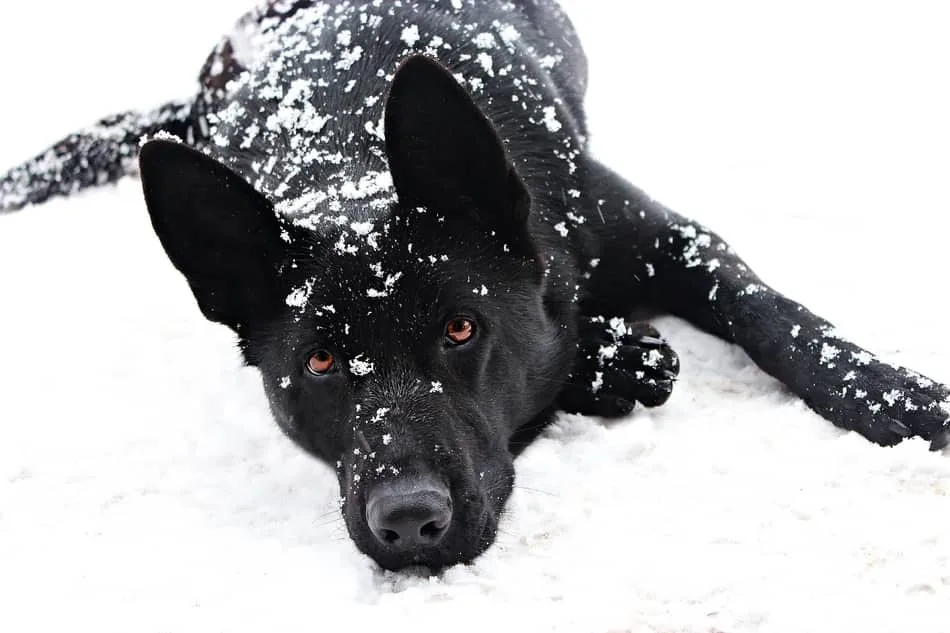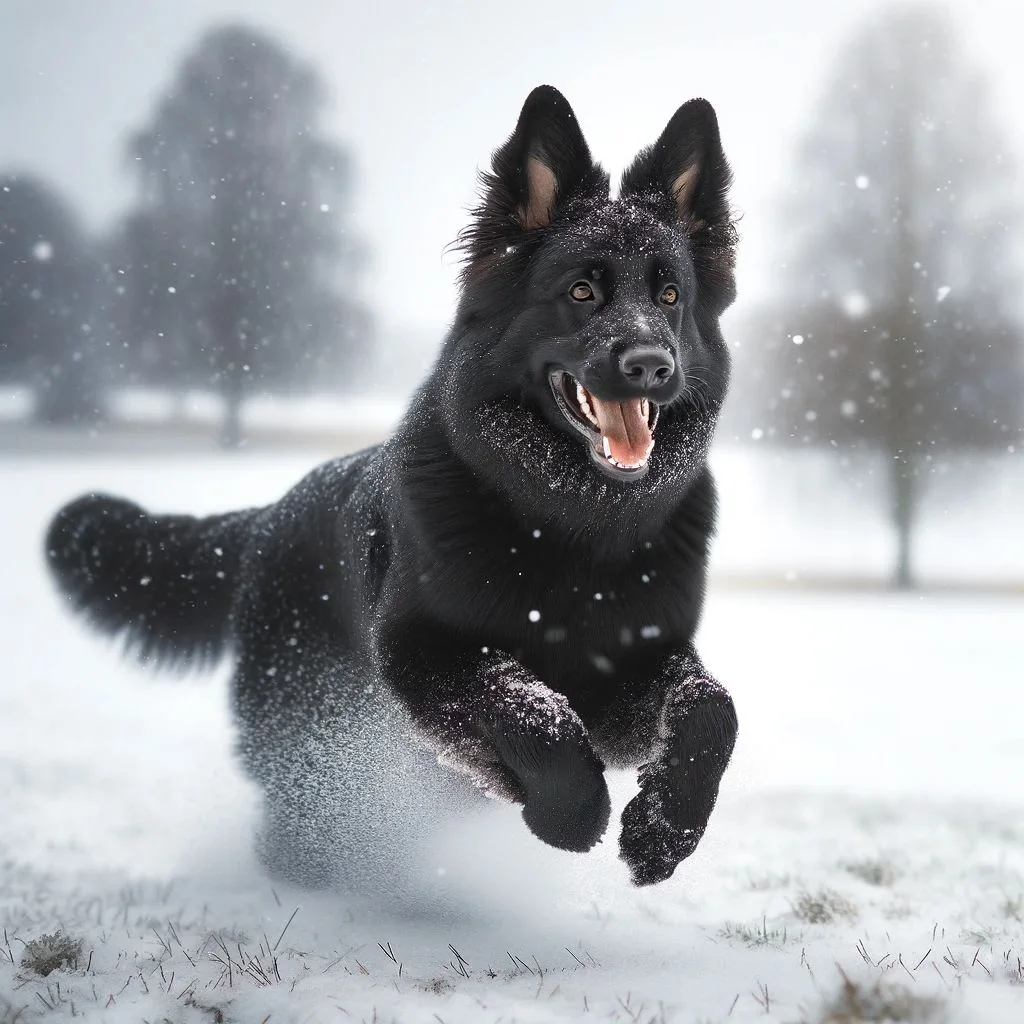One of my German Shepherds grew up primarily in the Midwest. Summers here are extremely hot and humid, and our winters are frigid with the occasional blizzard.
The extremes in weather in this region forced me to consider if a GSD would thrive in these conditions, or if it would be miserable.
So before I decided to buy a GSD in the Midwest, I spoke with a number of breeders and other GSD owners who I knew in the area.
So, what temperatures can German Shepherds tolerate?
The German Shepherd is an adaptable breed. Once acclimated, they can tolerate and do well in both hot and cold climates. It is important, however, in any climate, to provide a German Shepherd with the appropriate amount of shade, shelter, and water.
My dog seems to do well whether he is playing frisbee in the hot sun, or whether he is running through 3 feet of snow in below-freezing temperatures.
But keep in mind that GSDs are very focused dogs, and they will not always come to you and let you whether they are too hot or too cold.
So it’s up to you to pay very close attention to your dog and to understand when it’s time to either warm your GSD up or cool it down.

Click Here to Jump to a Section
Hot weather
Ensuring your dog remains hydrated in hot weather is crucial.
Dehydration in dogs is a significant risk, potentially leading to fatal outcomes, and is unfortunately often overlooked.
Instances where dogs knock over their water bowls, while not alarming for indoor dogs in a temperate environment, become problematic for those spending considerable time outdoors.
On hot days, water evaporates rapidly, elevating the risk. To mitigate this, investing in a spill-proof water bowl is a practical and cost-effective measure that could be life-saving for your pet.
Signs of overheating and dehydration
Keep a close eye on your GSD during hot weather.
If it is exhibiting any of the following signs or behaviors, you need to make sure that you take it indoors and provide it with fresh, clean water immediately.
- Thicker than normal saliva
- Lessening or loss of appetite
- Heavy panting
- Vomiting
- Diarrhea
- Generally tired with low energy
- A dry nose and gums
- Loss of skin elasticity
If you take your dog inside and these symptoms or behaviors do not improve quickly, then you need to take your dog to the veterinarian immediately.
Intervention at this stage is critical to avoid a potentially life-threatening issue.
Note on skin elasticity
According to dr. Jerry Klein, the chief veterinarian for the AKC, skin elasticity is probably the easiest way to check if your dog is dehydrated.
“Dr. Klein suggests that you gently hold some of the dog’s skin near his shoulder blades, raise it up, and then let it go.
Watch carefully as it falls back into place. In well-hydrated dogs, the skin instantly will spring back to its original position. T
he skin of dehydrated dogs, on the other hand, will take longer to fall back into place.”
However, the best way to keep your dog from being dehydrated is simply to avoid dehydration in the first place.
Always make sure that your dog has a clean supply of fresh water at all times.
Because dogs have individual requirements, it’s a good idea to ask your veterinarian how much water at a minimum that your dog should be drinking.
Though as a general rule, dogs should drink about an ounce of water per pound of their body weight per day. This will, of course, be dependent on your dog’s activity level and how hot the weather is outside.
Additionally, make sure that your dog always has access to shade.
Just like you seek out shade on a hot day, so does your dog. A dog kept in the hot sun without access to shade can quickly overheat and begin to dehydrate.
Your GSD’s fur and hot weather
Brushing your dog frequently during summer might seem intuitive, as excess fur seems to imply a warmer dog.
However, this common belief is a misunderstanding, especially when grooming a German Shepherd Dog (GSD).
Your GSD’s fur is multi-layered, functioning similarly to home insulation by trapping and retaining cool air.
Therefore, it’s important not to be overzealous in brushing your GSD.
Light brushing is key, focusing on removing only the fur that is naturally shedding.
Over-brushing and removing too much hair can disrupt this natural insulation, potentially leading to overheating in your GSD.
Cold weather

All of my German Shepherds have loved the snow. And it’s easy to get carried away while playing with them in it.
You may have experienced that they love to chase snowballs and just romp around having a good time.
But don’t forget that your dog may not even notice that it’s getting too cold. It is up to you to keep an eye on the time and closely watch your dog’s behavior to ensure its safety during cold weather.
I like to limit my dog being outside in the snow for about 30 minutes at a time maximum – if it’s a sunny warm day and the snow is melting a little, then I allow my dogs to stay out a little while longer.
But in this instance, I still keep a close eye on them because even though the air temperature is warm, they are still walking on the frozen ground and the pads on their paws are still susceptible to freezing on ice and snow.
This is different for dogs that are acclimated to the cold weather.
Typically, German Shepherds, once acclimated, can stay outside in very cold weather for long periods of time.
But if you have a mostly inside dog during the winter, it is the sudden change in temperature that you need to be careful of.
So use your common sense, consider how much time your dog does spend outside, keep an eye on your dog and adjust accordingly.
Bringing your dog inside from the cold
After a walk in the snow, it is good practice to thoroughly dry off your dog when it returns inside.
Not only does that lessen the smell of a wet dog, it also protects your dog from a few potential hazards which you may not have occurred to you.
While your dog is walking, especially if you live in a city, it can step on a number of things that are harmful to it. These include:
- Salt used to melt snow
- Antifreeze
- Deicers
These toxic substances may freeze to your dog’s paws, and will only begin to come off inside of your home where it is warm. And since dogs have a tendency to lick their paws, they can ingest these things.
So it is important that you thoroughly dry between your dog’s paw after you bring it inside.
Frostbite
Just like you, your dog can get hypothermia or frostbite. So it’s important that you take the proper precautions.
Be aware if your dog is experiencing frostbite. The signs of frostbite in your dog include:
- Pain to your dog when you touch the affected body part
- Swelling of the affected body part
- The affected area will be cold to the touch
- A gray or bluish discoloration in the affected area
- Blackening or dead skin in the affected area
It’s important to understand that signs of frostbite will not necessarily present themselves right after your dog comes in from the cold.
It can actually take several days before there is any clear indication of frostbite. At that time, the frostbitten area may become inflamed and painful to your dog.
Cold weather can also begin to crack your dog’s paws if exposed for long periods of time. So check on these frequently.
It is also a good idea to trim the hair between its pads. Ice accumulates and binds to this hair, which in turn and then freeze your dog’s paws.
If you are walking your dog in the cold and it begins to limp, it could be that it’s stepped on something, but this is also often a sign that it is just getting too cold.
It’s time to return inside of this is happening.
Cold weather and cars
Just like you would never leave your dog in a hot car during the summer time, the same goes for leaving your dog in the car during winter.
In cold temperatures, your car is basically a refrigerator.
Be aware of this, and do not leave your dog in the car on a cold day for an extended period of time.
Leashing your dog during cold weather and identification tags
Unless you have a fenced-in yard or know that your GSD will not leave your side, it’s very important that you always keep it on a leash during cold weather.
This is because snow and ice will mask the scents that your dog is used to following to find its way back home.
If your dog’s vision is impaired because of heavy snow and it cannot smell its way back home, it can get lost.
This happens to many dogs each winter.
So in addition to keeping your dog on a leash during walks, make sure that it has a snug-fitting collar with the proper identification tags in case your dog does become separated from you.
Feeding considerations
Staying warm burns calories. So be aware of this, and make sure that your dog is getting a high-quality diet in the proper amounts.
You may need to increase how much you feed your dog during the winter if it spends a fair amount of time outside. But don’t overdo it, you do not want your dog to begin gaining weight.
If you are unsure of exactly how much your dog should be eating, consult with your veterinarian, as each dog has its own individual requirements.
Puppies
If you are dealing with a puppy during hot and cold weather, keep in mind that they are not as developed as their full-grown counterparts. Because of this, they will be much less tolerant of heat or cold.
Afford your puppy the same considerations that you would to a child in these circumstances.
The key being to not overdo it in any one area with your puppy – spend less time in the heat, spend less time in the cold, be extra attentive to any signs of distress.
And if possible, make sure that your puppy lives indoors. While a GSD can live outdoors, it is not recommended at a young age.
An outdoor puppy is at a much higher risk to develop an illness or be adversely affected by extremes in weather.
Final thoughts
Although GSDs can live and thrive in just about any weather, your dog still needs all of the basics like food, water, and shelter.
Especially if you live in an area that experiences extremes in weather.
Treat your GSD with the same consideration that you would a person whom you deeply care about – because your dog most certainly cares about you, and it deserves as much love back from you as it gives to you.
